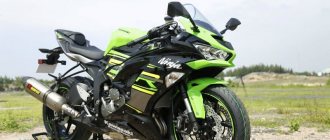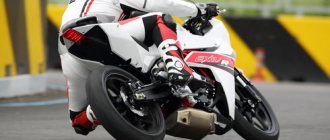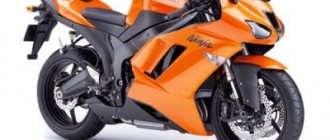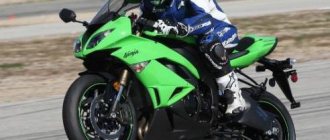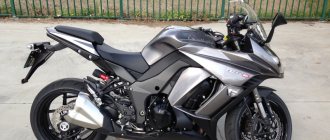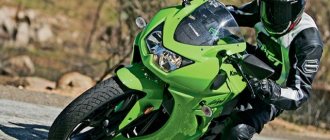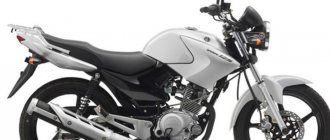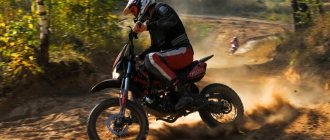Japanese ATVsKawasaki ATVs
The Kawasaki 750 model from Brute Force is large in size and is a utilitarian ATV.
A distinctive feature of the entire line is its versatility.
These ATVs are suitable for rallies and short-term pleasant trips, and can also become an aid in performing yard work.
Model description
It’s hardly possible to describe the Brute Force 750 in a nutshell, but we can safely talk about the progress of the developers .
Many of the initial shortcomings were gradually corrected , and today we have one of the best ATVs for off-road and not only among the Kawasaki ATV lineup.
What did they fix? Initially, the model did not have a very strong frame, which could bend or crack during long journeys with jumps and flights. Which, of course, made no one happy.
However, already in 2012, the company updated the frame, making it from steel tubes, reinforced at the fasteners.
This increased the operating time of the ATV , and also significantly improved its quality.
Anyone familiar with the early Kawasaki 750 models could see a clear analogy between the stamped steel wheels and the AvtoVAZ. They were durable and went everywhere they needed to go.
But they looked catastrophically meager and downright bad. Also in 2012, the developers pleased everyone with 6-spoke light-alloy wheels .
Such tires not only perform all the functions of the previous ones, but also weigh much less. Such an ideal concept loudly declared itself.
The model has disadvantages, although they are few.
To begin with, it’s worth saying that the ATV is very pleasant when riding on a dirt road or even just through the forest , but as soon as you drive out onto average-quality asphalt, that’s all - the steering wheel becomes steel, shaking, extended braking distances and inflexible turns make the ride less than pleasant.
However, there are many warnings on the ATV, such as “never use on public roads.”
Now it’s worth moving on to the most pleasant part of the description – the advantages. Brute Force did an excellent job creating the perfect ATV.
If you love extreme travel with ups and downs, then the Kawasaki 750 is your choice. It is also worth considering that the cross-country ability on grass, mud, stones, logs and other surfaces is beyond praise.
Don't even think that this big guy won't be able to gracefully turn into a power drift. A word about the brakes - if you press both levers in one instant, the Kawasaki Brute Force 750 will stand up abruptly. It just gets up and that's it. The main thing is not to fly out of the saddle.
The Yamaha Grizzly 550 ATV has absorbed all the best qualities from its predecessors, and “work on the mistakes” has also taken place. And what happened in the end you will find out from our article.
Here you will find the characteristics of an ATV that allows you to ride along the highway or travel off-road with equal comfort.
001_MOTO_0610_026
Kawasaki KFV750: ATV, 2009, 749 cm³, 50 hp, 170,000 rub.
Kawasaki KFV750: ATV, 2009, 749 cm³, 50 hp, 170,000 rub.
Still, a utilitarian ATV is not a racing car, why does it need so much? For economic purposes, even “five hundred” is enough. And drag a trailer with firewood, or attach a knife and clear the snow around a country house - “half a liter” will cope with these tasks with ease. So, then, either such muscles are for the amusement of vanity, or the utilitarianism of the quad is purely nominal? I have already noticed more than once that in Russia “utility bikes” are used “for housework”, that is, for their intended purpose, perhaps even less often than sport bikes for the track. And, apparently, not only here, otherwise would producers begin to fence the garden? But why does the whole world still unanimously use the term “utilitarian” ATV, if most of the devices were originally designed for entertainment, off-road riding and travel?
Specifications
The ATV engine has a V-shaped 4-stroke design with a volume of 749 cubic meters. see Number of horsepower - 51 .
The frame bridge is protected by plastic covers, and softer throttle return springs and the presence of ball bearings in their housings make the throttle feel lighter and less straining .
| Characteristics and performance of Kawasaki Brute Force KVF 750 4x4i | |
| Engine | 4-stroke 2-cylinder V-shaped engine, the cylinder camber angle of which is 90 degrees |
| Engine cooling | Liquid |
| Fuel system type | Injection |
| Ignition | Transistor |
| Frame | Tubular steel (high strength) |
| Type | Duplex |
| Suspension travel | Front travel: 169 mm |
| Reverse travel: 190 mm | |
| Front tire | AT 25 x 8-12 |
| Rear tire | AT 25 x 10-12 |
| Transmission system | 2 x-band continuously variable variator (reverse gear) |
| Main gear | 2/4 wheels on shaft (switching) |
| Front and rear suspension | Autonomous multi-link |
| Brake system | Front brake: double disc system with 2 x piston assistants (200 mm) |
| Rear Brake: Sealed multi-disc system | |
| Length | 2,095 |
| Height | 1.22 m |
| Width | 1.18 m |
| Wheelbase | 1,285 m |
| Ground clearance | 24 cm |
| Fuel tank volume | 19 l |
| Loaded mass | 316 kg |
| Turning radius | 3.2 m |
| Front track width | 9.25 cm |
| Rear track width | 8.9 cm |
The ATV has four main configurations:
- Basic;
- With electric power steering;
- SE with graphics and aluminum wheels;
- Realtree APG HD with camouflage texture.
The first point is clear. The second point is also very simple - EPS electric power steering makes driving easier and less tiring .
After all, when maneuvering in the forest without a booster, it is very difficult to quickly react and turn, precisely because a unit of this size will be stubborn.
In the third case, aluminum wheels and graphics are installed , which makes it light and stylish.
What is Realtree APG HD? Realtree specializes in camouflage that helps in hunting.
Therefore, for many hunters it will be good news that now the giant Kawasaki 750 will be barely visible in the surrounding surroundings.
002_MOTO_0610_027
The explosive nature of the engine does not really fit with the phlegmatic suspension settings, but it will give a savvy person real pleasure.
The explosive nature of the engine does not really fit with the phlegmatic suspension settings, but it will give a savvy person real pleasure.
Our test Kawasaki KVF750, the top model in the “green” company’s line, clearly belongs to this “secret” entertainment class. Switchable (by the way, right on the go) front-wheel drive, manual locking of the front cross-axle differential, low range in the variator - in a word, an off-road arsenal that will be the envy of other “adult” jeeps! Considering the quad in this particular format, the V-shaped engine layout and 4-valve cylinder heads and 50-plus horsepower look quite adequate. After all, the task is to “burn”, and not to drag a trailer with manure. For these purposes, a two-valve “single-barrel” would be just right, so that there would be more thrust at the bottom, and a richer one.
Estimated cost
The new Brute Force ATV of the 2015 model year costs approximately $12,500-13,500.
A used one, but in good condition, can be purchased for $5,500 – $6,300 for various years of manufacture.
The Suzuki Kingquad 750 ATV model looks stylish and modern, although there is enough unstoppable power hidden under its sparkling armor.
Review of the most modern ATV from the “Grizzly” family from the Yamaha concern, which has gained popularity since the beginning of its production.
003_MOTO_0610_027
The very soft suspension is more “tailored” for a recreational driving style, but it is not low on energy consumption: it allows you to both jump and “goat.”
The very soft suspension is more “tailored” for a recreational driving style, but it is not low on energy consumption: it allows you to both jump and “goat.”
I went to an abandoned sand quarry to test the “vertical take-off harvester”. Here, in a small area, almost all possible off-road “goodies” are concentrated: loose sand, rolled primers and tooth-crushing graders, ravines, steep ascents and descents, a pine forest with swamps and even a real ford almost waist-deep. The first impression is unexpected: the engine does not catch on for a long time, until you apply the gas. It’s a completely natural behavior for a carburetor, but here it’s injection! I thought that this effect would disappear as the engine warmed up, but the engine was just as reluctant to start “hot” without gas. Didn’t the “ecologists” really try their best to deplete the mixture so much? Anyway. “Stability is a sign of a professional,” so I attributed this “jamb” to the features of the model.
Photo gallery
Fans of this ATV repeatedly say that nothing can be better than it, thanks to its excellent characteristics and cross-country ability. You are given the opportunity to study its external qualities and more clearly form your idea of Brute Force 750, which has already won the hearts of many.
004_MOTO_0610_027
The absence of an electric booster, although it complicates the control of a heavy device, but the likelihood of performing “ears” is noticeably reduced, and feedback is sometimes more important.
The absence of an electric booster, although it complicates the control of a heavy device, but the likelihood of performing “ears” is noticeably reduced, and feedback is sometimes more important.
On the move, the Kava turned out to be very soft. Suspensions without a trace swallow not only small “graders”, but also quite serious gullies, so when driving on an ordinary field or on a dirt road of moderate severity, you can not only not get up from the saddle, but read the newspaper. No shaking. The quadr handles large (more than 30 cm) holes and potholes very softly and delicately. Despite all this, I never managed to break through the suspension. Progressive springs do their job perfectly. So, in terms of comfort, the KVF750 beats its direct competitors (Honda TRX 680 and Yamaha Grizzly 700) by twenty points. I think if you put a passenger seat on this Cava, it could easily compete with the Polaris Sportsman 850, which is equipped with a sophisticated system of personal suspension for the passenger seat.
006_MOTO_0610_027
Separate headlights are responsible for high and low beam.
Of course, such light will not be enough for rally raids, but for country drives it will be more than enough. Separate headlights are responsible for high and low beam. Of course, such light will not be enough for rally raids, but for country drives it will be more than enough.
And it’s easy to overdo it with gas. The 50-horsepower engine responds to the pilot’s commands very willingly, even abruptly, spitting the not-at-all-light quadric forward out of any mud and up any hill. And in a lower gear, “Kvaka” gets into the “candle” even on a flat surface, and if the road climbs even a little upward, generally “turn out the lights”! In general, you need to be extremely careful with acceleration, and I would not advise beginners in the ATV business to get behind the wheel of this device at all. With taxiing, the situation is just the opposite. Turning the steering wheel of a heavy car turned out to be difficult even for me, a person who does not suffer from rickets at all, and after half an hour of “racing” along the gullies, my hands even began to ache. And why Kawasaki didn’t follow the global trend and equip a heavy machine with an electric booster is not entirely clear, because almost all serious companies have been equipping their heavy quads with this useful device for a long time. It’s scary to think what it will be like on the KVF in a real swamp and on “toothy” tires!
Modifications
2004 Kawasaki Z750.
2005 Kawasaki Z750S with front fairing.
As already mentioned, the motorcycle was offered in three modifications.
- Kawasaki Z750 - basic equipment. Naked. Launched in 2004, received ABS and other updates in 2007, closed in 2013.
- Kawasaki Z750S - born in 2005. However, it is not in great demand and during the 2007 update it is considered unprofitable, after which it leaves the assembly line.
- Kawasaki Z750R - appears in 2011. The version receives a sports suspension, the front brake calipers become radial, and a 4-piston support bracket is installed. Interestingly, the year the production of the model ended is not clear. Either together with the basic one, or a year later.
005_MOTO_0610_027
The ergonomics of the workplace and the ease of seating are conducive to leisurely walks along the surrounding “pampas”, but even in a “combat” stance it is at ease.
The ergonomics of the workplace and the ease of seating are conducive to leisurely walks along the surrounding “pampas”, but even in a “combat” stance it is at ease.
Royal comfort turns into a “soft spot” for the pilot when the walking pace ends and the “rubilovo” begins. Even a driving pace slightly higher than walking provokes strong vibrations of the vehicle, both in the transverse plane - during turns, and in the longitudinal plane - during acceleration and braking. It turns out that controlling this “winged swing” is not at all easy! Not only do you have to hold on tightly to the steering wheel so that the next dive during braking does not catapult you into the air in front of the car, you also have to register turns literally like a jewel - the car in turns strives to stand on its “three bones” simply with Komsomol enthusiasm. Twist the steering wheel a little or rev the throttle, and hello “ears.” At the same time, the shock absorbers have only one adjustment - by pre-compressing the spring, so it will not be possible to tighten them “to suit yourself”.
and competitors
Yamaxa FZ6.
Suzuki GSR750.
Honda Hornet CB 600.
FZ6
The Yamaha developers did this best. Their model Yamaxa FZ6, and then FZ8 (father 6 and 8, respectively) actively stepped on its heels, had modifications naked and with a fairing, and ultimately won the fight - Fazer 8 forced Kawasaki to think about a more powerful model.
GSR750
Suzuki did not want to stand aside - its GSR750 model also had two design options, and the version with a fairing even had carbon parts, but did not gain an advantage. Neither Yamaxa nor Kawasaki took the carbon fairing seriously.
Hornet (CB 600)
Honda at that time did not have a suitable motorcycle, as it was actively promoting the Hornet model (CB 600). I put her out. The second and third generations could match the capabilities of the Z750, but did not make any impact on the market.
Dimensions and weight
The Kawasaki Z750 is a typical mid-weight naked bike (another name is streetfighter).
Due to the change of generation, the weight of the motorcycle has increased slightly:
The curb weight was 218 kg before the generation change and 226 kg after the change. The appearance of ABS increased the weight to 230 kg.
The version with a fairing, which was mentioned just above, weighed 222 kg.
The dimensions have also changed:
- became longer - from 2,080 to 2,085 mm;
- thickened in width - from 780 to 805 mm;
- the height also increased - from 1,055 to 1,100 (version with fairing 1,180) mm;
The saddle height has not changed - 815 mm.
The wheelbase has become longer - up to 1,440 mm, and the ground clearance is lower - up to 155 mm.
For whom is it intended?
The seat on the bike is narrower, stiffer and shorter compared to its predecessor.
It is curious that if the buyer found the saddle too high for him, he was offered a version with a fairing, where it was 10 mm lower. Tall bikers could be offered one of the modifications, where the saddle was higher - 825 mm.
A pleasant surprise
In general, although the Brute Force boasts nice and interesting solutions like the locking lever and the location of the air filter, at first glance it still seems like the most banal Japanese ATV. But sea trials showed that this is not entirely true! An updated engine, variator settings and, perhaps, some Japanese magic unknown to me make this all-terrain vehicle quite angry and sharp. Despite the modest 50 horsepower, the Kawasaki KVF 750 rides no worse than its larger cubic brethren in the flagship class. We did not carry out special measurements, but the “Japanese” feels not much inferior to the liter Canadian and Japanese models. The power plant is simply superb. “Kvadrat” reacts very sensitively to manipulations with the gas trigger and, at every opportunity, launches a three-hundred-kilogram car into a controlled side drift. But in every barrel of honey there is sure to be a drop of bitter machine oil. The car's simple and unsightly suspension does not at all correspond to the cocky nature of its power plant. If you drive, as they say, with all your money, then they simply will not have time to work off all the obstacles encountered under the wheels. So to use the Japanese fighter in country and rally racing, its suspension will have to be modified. The second rather significant drawback that I would like to note is the overly intrusive operation of the power steering. At high speeds, there is practically no feedback on the steering wheel and the driver may well make a fatal mistake when piloting. But if you install a competent suspension system on the Brute Force, invigorate the power plant a little more and turn off EPS, then the KVF 750, especially considering its cost, may well become a real competitor to the sports models of Polaris and Can-Am. Also, in fairness, I would like to note that if you have the “correct” mud tires, the stock Kawasaki becomes almost all-climbable.
In general, taking into account global currency conflicts and the depreciation of the ruble, this Japanese ATV may turn out to be a very attractive acquisition that will allow its owner to truly enjoy the full range of off-road all-wheel drive leisure. After all, the potential of this car is enough for both tourist adventures and amateur sporting events of almost any level.
Perfection without the fuss
Having become acquainted with the latest catalogs of motorcycle equipment that a well-known company offers its clients, it is easy to see that by the term “improvement” Kawasaki developers do not mean a radical change in image and the annual appearance of completely new models on the market. They chose the path of gradual improvement, bringing the design to perfection through improvements that really matter. This is roughly how the famous Japanese gunsmiths created their beautiful swords.
010_MOTO_0610_027
Quite ordinary in terms of design, the device copes with its functions perfectly.
Everything you need is in front of your eyes, unnecessary information is not an eyesore. Quite ordinary in terms of design, the device copes with its functions perfectly. Everything you need is in front of your eyes, unnecessary information is not an eyesore.
Advanced ATV riders often tune their cars beyond recognition: a suspension lift, bigger wheels, worse tires - everything in order to get stuck where no jeep can reach. So, in my opinion, in the conditions of a real “rubilov”, this “grasshopper” will not lag behind the “combat” vehicles by a meter and will successfully get stuck with them in the same, most distant and impassable swamp, which competitors will not be able to reach. Well, in order to successfully get out of it, from all the tuning, I would install a winch on the KVF and a little “toothier” tires. And that's enough.
008_MOTO_0610_027
The steering wheel switches and levers are intuitive, accessible and easy to use.
The steering wheel switches and levers are intuitive, accessible and easy to use.
The most interesting and paradoxical thing in the whole story is that, despite all the negative impressions described above, I really liked the quadric. This happens, and not only with technology. Sometimes you look at a woman - and her nose is crooked, and her eyes are different, and her ears are protruding, and there are freckles... but you can’t tear yourself away - individually awkward parts give absolutely stunning beauty. And now, all these seemingly minuses add up to such a fat and absolute plus that you are amazed! In general, the KVF750 is most similar to a BMP - an infantry fighting vehicle. It also has a very soft suspension, as a result of strong body sway and an angry engine, which allows you not just to “start vigorously”, but literally “jump” from a place. A kind of grasshopper.
007_MOTO_0610_027
An unusual lever above the brake is a manual locking of the front cross-axle differential.
By the way, the differential itself has a constant partial “pressure”, so that the torque, albeit partially, will always be on both wheels. An unusual lever above the brake is a manual locking of the front cross-axle differential. By the way, the differential itself has a constant partial “pressure”, so that the torque, albeit partially, will always be on both wheels.
But with the brakes everything is in perfect order. The front disc brakes settle the car like sand on a bullet. For most everyday situations, one “front end” is more than enough. But the rear multi-disc brake, operating in an oil bath in the rear differential housing, was a little disappointing. Working in oil makes it rather “brooding” and “cotton”, so it can only be used as an addition to the front one.
Flaws
According to users, the driver's saddle allows you to travel 80–100 kilometers tolerably.
Among the disadvantages, users note:
- The checkpoint does not create any problems, but you still have to get used to it.
- The saddle is not very comfortable for long distance riding. The part for the second number is also quite tough;
- Fuel gauge on the dashboard.
When parked, it lies shamelessly. It only shows normally when in motion. If the reserve inclusion limit is reached, information about this closes the odometer. The instrumentation itself is of a mixed type - a dial tachometer and a digital speedometer display.
Most users note that ABS is needed, but there are no obvious complaints about the brakes.
and dignity
- Power - for city driving 4-5 kW is enough.
- Controllability.
- Heavy weight.
- Good weight distribution - difficult to spread out.


